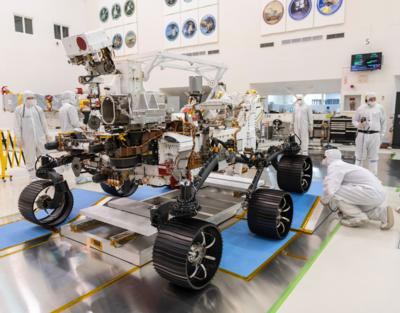Look Upon My Works, Ye Mighty …
NASA’s Perseverance rover is a car-sized, six-wheeled marvel designed and deployed to explore Mars’s Jezero crater as part of the agency’s Mars 2020 mission. Envisaged and manufactured by the boffins at California’s Jet Propulsion Laboratory, Perseverance was launched on 30 July 2020, and touched down on the red planet’s surface in February 2021. As of 16 February 2023, the contraption has been dutifully traversing Mars’s inhospitable vistas for 708 sols (728 Earth days).

Over the course of five-weeks beginning in December 2022, Perseverance busied itself constructing a sample depot atop a patch of Martian ground called Three Forks. Presently, the cache comprises ten sealed titanium tubes—eight containing samples of Martian rock and regolith, one containing a sample of Mars’s atmosphere, and a witness tube pre-loaded with materials capable of capturing molecular and particulate contaminants potentially detrimental to the mission’s scientific objectives.
NASA and the European Space Agency (ESA) seek to retrieve and transport the cached sample tubes to Earth in approximately ten-years’ time.
The retrieval endeavor’s fundamental architecture calls for Perseverance to deliver the cached tubes to a NASA lander which, once loaded, will ascend to Mars orbit, where a waiting ESA-built spacecraft will secure the payload of sample tubes and return such to Earth—perhaps as early as 2033.
The lander and ESA retrieval craft are slated to launch in 2027 and 2028, respectively.

Presently, Perseverance is functioning nominally—a term denoting full functionality in the argot of space exploration. How long the rover remains in good working order on barren and brutal Mars—the average surface temperature of which is negative 81°F—remains to be seen. Ergo, the Three Forks depot exists as a contingency.
In the event of Perseverance’s failure, a pair of rotorcraft similar in design to the Ingenuity helicopter—a small robotic rotorcraft by which the Perseverance rover was accompanied to Mars, and the first manmade craft to complete an extraterrestrial atmospheric flight—will deploy from the retrieval lander and fetch the depot tubes individually.
For purpose of documenting its depot-building enterprise, Perseverance snapped a comprehensive series of photos capturing the Three Forks project site. NASA personnel subsequently compiled 368 of the photographs into a panorama depicting the locations of the ten cached sample tubes.
Since arriving on Mars in February 2020, Perseverance has been about the business of investigating Martian astrobiology, primarily by gathering rock and soil samples NASA scientists posit may contain signs or vestiges of ancient microbial life.
NASA associate administrator for science Thomas Zurbuchen stated: “We picked the Jezero Crater for Perseverance to explore because we thought it had the best chance of providing scientifically excellent samples—and now we know we sent the rover to the right location.”
Geologists theorize the delta Perseverance has passed the last several months investigating formed approximately 3.5-billion years ago at the confluence of a Martian river and lake.
Perseverance project scientist Dr. Ken Farley of Caltech remarks: “The delta, with its diverse sedimentary rocks, contrasts beautifully with the igneous rocks—formed from crystallization of magma—discovered on the crater floor. This juxtaposition provides us with a rich understanding of the geologic history after the crater formed and a diverse sample suite. For example, we found a sandstone that carries grains and rock fragments created far from Jezero Crater—and a mudstone that includes intriguing organic compounds.”
On 20 July 2022—the 509th Martian day of its mission—Perseverance investigated Wildcat Ridge—a rock outcropping about three-feet (one-meter) wide that likely formed billions of years ago as mud and fine sand settled in an evaporating saltwater lake. The rover extracted cylindrical samples from the geological formation before analyzing the substrate with an instrument NASA refers to–somewhat contrivedly–as Scanning Habitable Environments with Raman & Luminescence for Organics & Chemicals, or SHERLOC.
Within the Wildcat Ridge samples, SHERLOC detected a class of organic molecules spatially correlated with those of sulfate minerals. Within sedimentary rock, such minerals often yield information germane to the aqueous environments in which they formed. The organic molecules present within the Wildcat Ridge samples were the most abundant yet discovered on Mars.
Organic molecules consist of a wide variety of compounds comprising primarily carbon, hydrogen, and oxygen atoms; though nitrogen, phosphorus, and sulfur are also commonly observed. The presence of such molecules speaks—albeit not definitively—to the presence or one-time presence of life.
Laurie Leshin, director of NASA's Jet Propulsion Laboratory in Southern California, asserts: “I’ve studied Martian habitability and geology for much of my career and know first-hand the incredible scientific value of returning a carefully collected set of Mars rocks to Earth. … We will learn so much.”
 ANN's Daily Aero-Term (04.25.24): Airport Rotating Beacon
ANN's Daily Aero-Term (04.25.24): Airport Rotating Beacon ANN's Daily Aero-Linx (04.25.24)
ANN's Daily Aero-Linx (04.25.24) Klyde Morris (04.22.24)
Klyde Morris (04.22.24) Airborne 04.24.24: INTEGRAL E, Elixir USA, M700 RVSM
Airborne 04.24.24: INTEGRAL E, Elixir USA, M700 RVSM Airborne 04.22.24: Rotor X Worsens, Airport Fees 4 FNB?, USMC Drone Pilot
Airborne 04.22.24: Rotor X Worsens, Airport Fees 4 FNB?, USMC Drone Pilot




